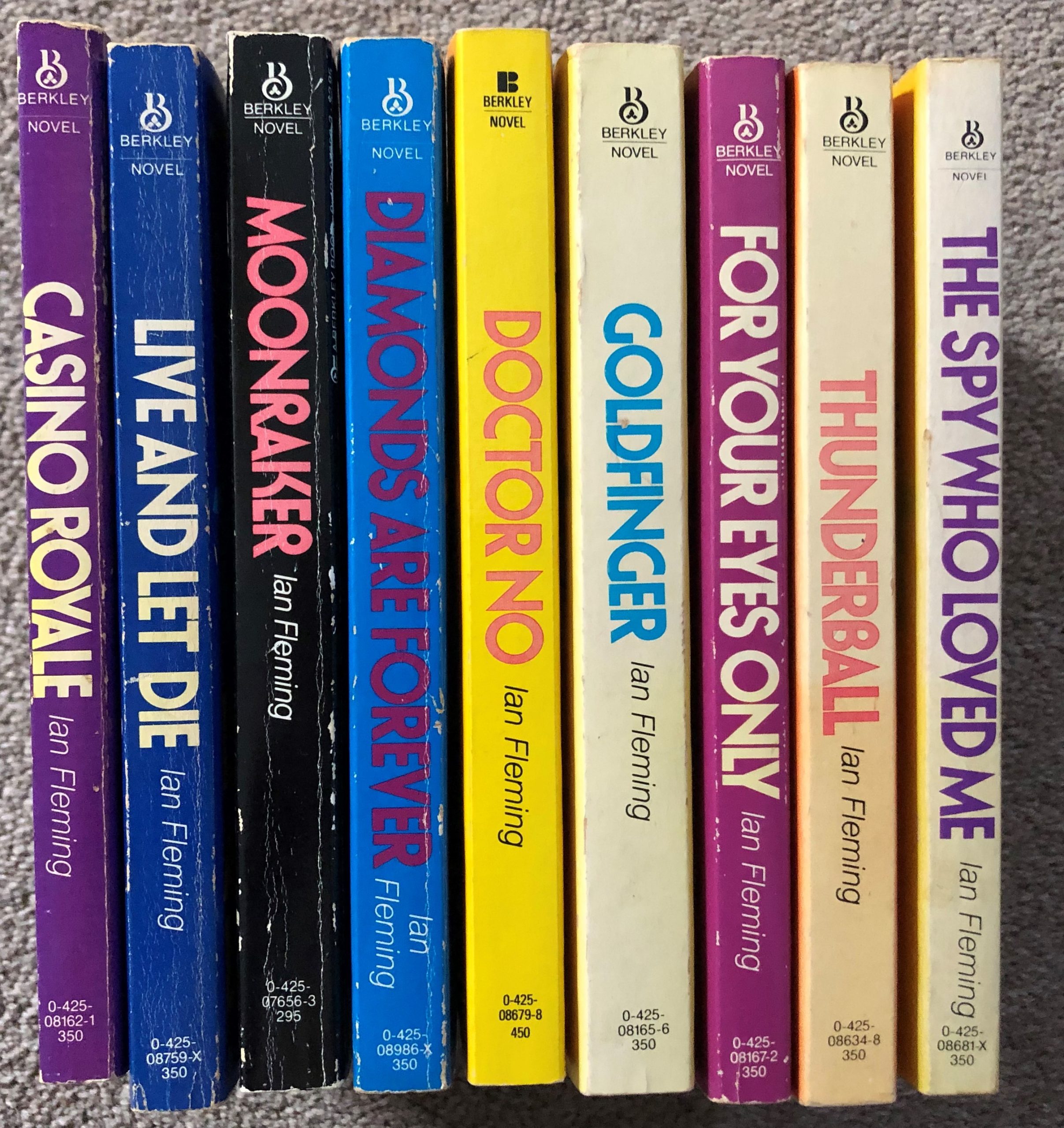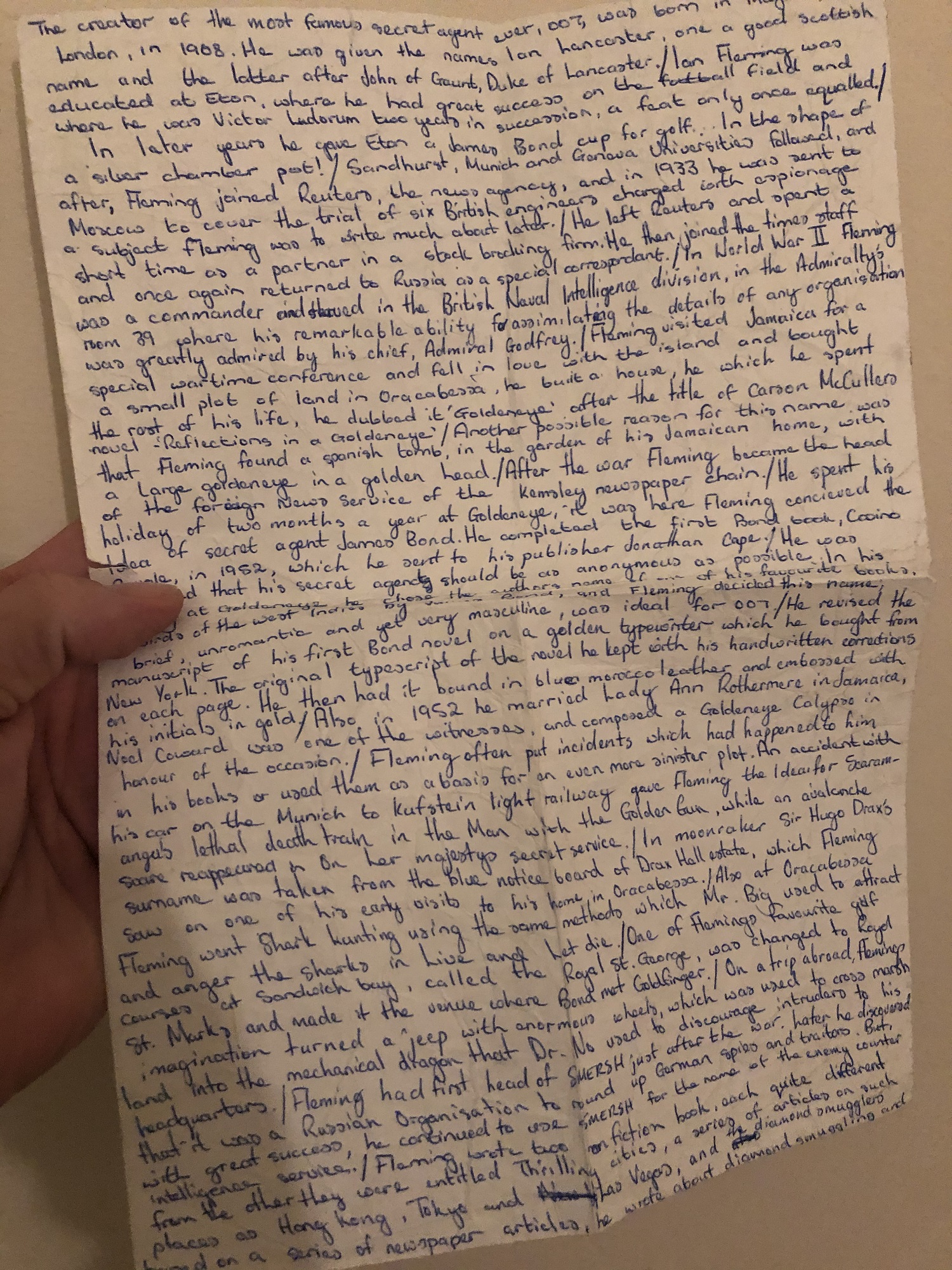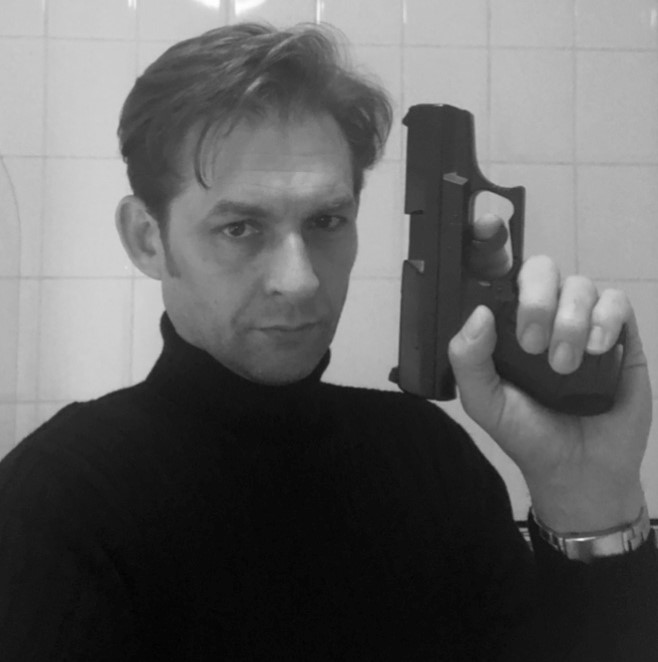A PERSONAL HISTORY OF A SPY WHO I LOVE
The year is 1976, it’s November 3rd, I am three years old and, as unbelievable as this may sound, I have just been introduced to the world of secret agent James Bond 007 via ITV broadcasting 1964’s Goldfinger for the first time on UK television.
I have always had very good memory (particularly of geeky things) and I can remember sitting watching the film with my parents. Moments that I remember from the movie were Q showing Bond the gadgets on the Aston Martin DB5, the DB5 chase scenes – particularly the parts where the baddy is ejected and Bond crashes the car (I was quite upset that the car was damaged!), the laser aimed at Bond, the villainous Oddjob, with his deadly hat, who I was very scared of, the bomb being stopped and the timer stopping on 007, and Goldfinger being sucked out of the aeroplane at the end of the movie. What stays with me more than anything is the way the film made me feel – excited, wanting to watch those scenes again.
Whether it was right or wrong that my parents let me watch the movie can be debated but I know I thoroughly enjoyed it and it began my life-long love of James Bond.
Not long after this my mum bought me a Corgi Aston Martin DB5 (which I still have and am planning to restore as it is “play worn”) and a Lone Star James Bond pistol that was gold with a black handle and silencer (I always thought it was meant to be The Man With The Golden Gun pistol, I’m not convinced this is the case.) This allowed me to recreate the chase scenes with my toy cars and pretend to be James Bond.
Over the next few years, ITV premiered many of Sean Connery’s outings as Double-O-Seven and I was fortunate enough to be allowed to watch these too. Again I have memories of each movie, particular stand-out moments that stuck with me were the jet-pack from Thunderball and the disappointment that the DB5 was only featured momentarily, You Only Live Twice’s gyrocopter; Little Nellie, being assembled from the cases and the subsequent aerial dogfight with Blofeld’s helicopters, a different Bond in On Her Majesty’s Secret Service (who I accepted without question) and then on Christmas Day 1978 Diamonds Are Forever with Bond being nearly burnt alive in a coffin and the Lunar Buggy chase. I remember this Christmas very clearly as it was also the year I received a Palitoy Star Wars Landspeeder and X-Wing (having been to the cinema with my parents for the first time earlier that year to watch Lucas’ classic science-fantasy film).
“WHERE ALL THE OTHER BONDS END . . . THIS ONE BEGINS!”
My dad took me to see a few films in the late 70s/early 80s, these were: Superman, Battlestar Galactica, a certain Bond movie, Star Trek: The Motion Picture and Ghostbusters. Generally, my mum took us to the cinema and invariably sat through sci-fi and fantasy films that she didn’t really like, so these few times with my dad have stayed with me.
1979 was the year when I experienced James Bond in the cinema for the first time and Roger Moore’s suave interpretation of the spy. Moonraker is still one of my favourite Bonds and that is probably because it combined my love of the character with the sci-fi that I had become hooked on. Again there are so many memorable scenes in the film, the cable car fight with villain Jaws, the centrifuge where Bond almost passes out and dies, the shuttle launch and climactic space battle against Drax’s army and Jaws helping Bond to escape. Another highlight of the cinema trips was the interval when the usherette, serving refreshments, would come into the auditorium and I’d have a small tub of ice cream with a wooden “spoon” to eat it. I miss those intervals.
Again there were some pieces of merchandise for the movie that were aimed at children. Corgi produced a Moonraker shuttle complete with opening cargo doors, satellite and retractable landing gear and Lone Star released a cap-firing version of the laser rifle featured in the space battle (both of which I still have and again plan to restore in the future). I also received the Moonraker annual for Christmas that year which was to prove useful many years later. Such things allowed me to recreate what I had seen on screen and learn more about the secret agent.
Fortunately, ITV continued premiering Bond movies and Roger Moore’s debut Live and Let Die was shown at the end of January 1980, The Man With The Golden Gun was broadcast on Christmas Day of the same year.
“IT'S THE BIGGEST. IT'S THE BEST. IT'S BOND AND BEYOND!”
The one Bond film I was waiting for had been featured briefly on BBC1’s children’s quiz show Screen Test, which was presented by Brian Trueman when I watched it. The quiz involved its young contestants watching clips from films, and then being asked questions about them to test their memories of what they had seen. As a seven-year old obsessed with gadgets seeing the Lotus Esprit submergence sequence from The Spy Who Loved Me was a big deal. Here was a car that competed with the DB5!
I actually had the large Corgi Lotus with its retractable fins and firing missiles way before I saw the film on TV and I can remember my mum buying it for me on a trip to Asda in West Bridgford, Nottingham around the same time that Moonraker was released. Toy cars had longer shelf lives back then and Bond cars were always reissued; the Esprit was produced from 1977 to 1980.
I would have to wait a further two years (it premiered on ITV on March 28th 1982) to see the film and fully appreciate the spectacle of the car chase between Lotus, motorbike with explosive sidecar, Ford Taunus Ghia (Cortina in the UK) and helicopter, with the car’s transformation into a submarine, subsequent destruction of chopper via missile and skirmish with Stromberg’s frogmen and mini (yellow) submarine. The added bonus was the “return” (for me) of Jaws who I absolutely loved, loathed and feared as a villain. It was a film that didn’t disappoint me and which I still enjoy very much along with Moonraker.
“NOW PAY ATTENTION DOUBLE-O SEVEN.”
It was also around this period in 1983/84 that I was bought a really great birthday present of a Zeon James Bond OO7 LCD Digital Melody Alarm Watch (which was first produced in 1981). This was such a cool watch as not only did it have a stopwatch and a light to illuminate the screen but it played Monty Norman’s signature Bond theme. I have the watch to this day but alas the alarm no longer works despite my attempts at restoring it. The watch felt like my first “adult” one at the time, I’d have to wait quite a few years until I had another Bond-related timepiece.
The advent of VHS made watching new Bond movies more accessible and with less of a wait. In the early and mid-eighties Moore’s next few outings as the suave secret agent hit the cinema as did the return of Sean Connery as OO7 in the Jack Schwartzman/Kevin McClory produced Never Say Never Again.
As I got older I was also more aware of the music of the movies and View To A Kill by Duran Duran and The Living Daylights by A-ha were the first two Bond themes that I remember being in the charts and both by bands I loved. As music became a really large part of my life I looked forward to each new movie bringing a new song by a different artist, and still do.
Moore’s departure in 1985 was the end of an era in many ways for me personally. I had completed my first year at secondary school and many of the things I had loved in the late 70s and early 80s seemed to be changing as I began to make the transition from childhood to teenage years.
Timothy Dalton’s 1987 debut movie The Living Daylights really reignited my interest in Bond (not that I had ever lost interest in the series) and as a 14-year old, I really liked the more hard-edged nature of his portrayal of the super-spy that recaptured something of Connery’s era (who, despite having been a fan of Moore, was my favourite Bond). Then three things happened that moved my love of Double-O-Seven to another level.
“NEVER SAY 'NO' TO ADVENTURES. ALWAYS SAY 'YES,' OTHERWISE YOU'LL LEAD A VERY DULL LIFE.”
The first thing was that one Saturday afternoon, on a shopping trip in Hucknall, I picked up a cheap hardback copy of Ian Fleming’s Dr No and From Russia With Love in one volume from a local family run chain-store called Fords (now long-gone). I devoured those stories and enjoyed that, although they shared many elements with the films, they were different to the movie scripts and so it was like a whole new world of Bond was waiting for me to discover.
Secondly, my dad was sorting out some of his old things and getting rid of stuff that had been in the back of his wardrobe for years and came across a hardback copy of a book he thought I’d like and that he had forgotten he owned. Although the dust jacket was missing I was more than happy to find it was a copy of Fleming’s final Bond adventure; The Man With The Golden Gun. This is the story that really changed my perception of just how the films diverged from Fleming’s novels. The plot of 1989’s Licence To Kill seems to share much more in common with this novel than the movie adaptation.
Although it is often cited as a weaker Fleming story (it was published eight months after his death) it really did have a profound effect on me. So much so that I can remember creating a poster paint A3 picture in art classes at school depicting the scene where Bond confronts Scaramanga on his ‘death train noticeably totally absent from the film as are so many of the plot points.
The family holiday in Great Yarmouth was the third thing that year, indeed that summer, which shaped my newfound love of Fleming’s novels and the character of Bond as on the page. One of the seaside shops was a treasure trove for geeks, the owner was a huge comic-book fan and had lots of old DC and Marvel back issues for sale in the shop. My brother and I spent ages going through the rotating wire magazine holders and I bought a lot of DC first series Star trek comics (at ridiculously low prices back then).
Going in later in the week I noticed that the bookshelves near the comic racks had been replenished and what immediately stood out to me was the brightly coloured James Bond novels that were gracing them. Casino Royale, Live And Let Die, Diamonds Are Forever, From Russia With Love, Doctor No, Goldfinger, Thunderball, The Spy Who Loved Me, For Your Eyes Only and Moonraker – all U.S. paperbacks published by Berkley. Each book was 99p each – I was in Double-O-Heaven! My holiday money was officially exhausted.
“YOU HAVE AN ASSIGNMENT, AND I EXPECT YOU TO CARRY IT OUT OBJECTIVELY AND PROFESSIONALLY.”
1989 was the year I was leaving secondary school and moving on to college. First I had GCSEs to contend with and even these were to have a Bond theme. My English Literature and Language exams included an oral test that consisted of preparing a three and a half minute talk on a subject of my choice.
I opted to research and give a brief talk about the life of Ian Fleming and the creation of James Bond. As this was pre-internet the library and my own books were the only methods for putting together this speech. Luckily the Moonraker annual from 1979 turned out to be a great source of information about Fleming’s life and how he developed Bond. It sounds strange but I revised this speech so many times that I can still recall lines from it without the aid of the notes I had made to take in with me – one side on a postcard size piece of paper –I didn’t use it once. I can remember being nervous as I stood in front of Mrs Ware and began to reel off details about the author and his creation. I still have those notes, and it is so odd seeing the 15-year-old me’s handwriting and reading back my words. I cannot imagine feeling those nerves about public speaking now as my day job (teacher) is largely based around it at various levels.
I passed the exam so it must have gone down well!
“IN MY BUSINESS YOU PREPARE FOR THE UNEXPECTED.”
1989 was also the second, and unfortunately final, outing for Dalton in the brilliant and underrated Licence To Kill. This back to basics OO7 movie was the first that was not fully based on Fleming’s novels, although it did take elements from various short stories, and was the first to not have a Fleming title. However, the attitude and the brutality of the film were straight out of Fleming’s original texts. Dalton’s characterisation was darker, brooding and more violent than had been seen before and it earned the franchise its first 15 certification.
I bought the novelisation of the film and discovered more Bond novels, which I had not realised existed, in the form of John Gardner. Another family holiday in 1990 resulted in me purchasing a James Bond Movie Poster book and The Making of Licence To Kill from an indoor market in Blackpool.
My only regret is that I did not buy the Matchbox car set for Licence To Kill which I saw in Woolworths when I bought the Gladys Knight single and wanted, but decided I was too old to buy (I still look at it longingly on EBay!)
And so a new decade had begun. 1991 saw me leave college and embark on my university adventure, and in the back of my mind, Dalton would be returning that year for more adventures as the world’s most well-known undercover agent. Little did I know that was not meant to be.
The End (of part 1)
James Bond will return
Deinde usque ad tempus
Gary




















Enjoyed reading your post. You must fall into the James Bind superfan category. Hope you can get your Corgi car restored.
Brilliant! Very, very jealous of your 7” vinyl The Living Daylights…can’t believe I don’t own one!
The whole blog totally took me back; the mention of Fords (a regular Friday jaunt in Eastwood as a kid) and seeing Ghostbusters in the cinema with the interval ice-cream with wooden spoon!
Looking forward to part 2. 🙂
Thanks Mel, glad you enjoyed it. Hopefully you can find a Living Daylights 7″ vinyl! Glad it took you back, we always aim to bring back memories with these blogs.